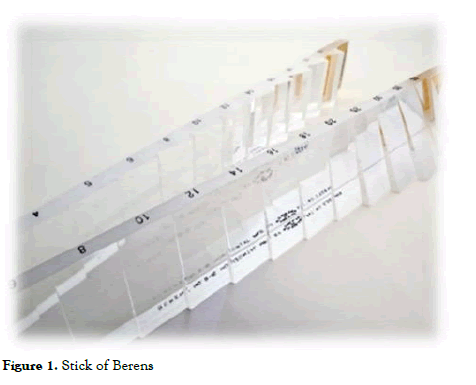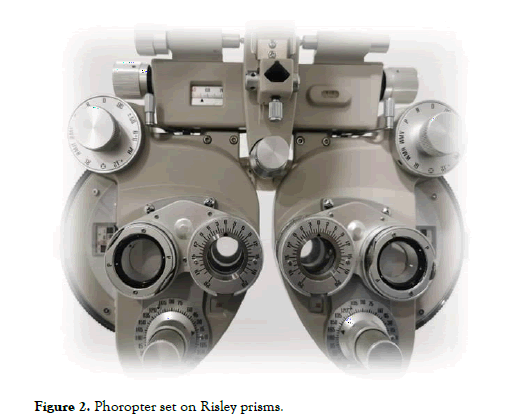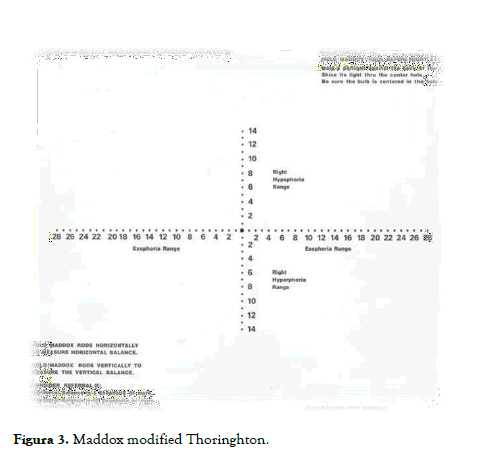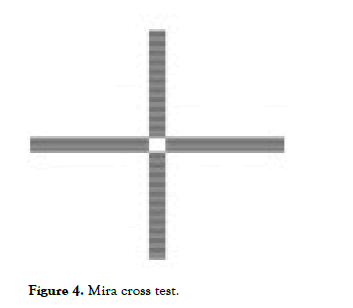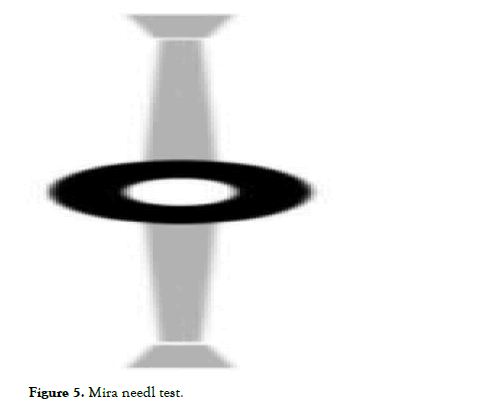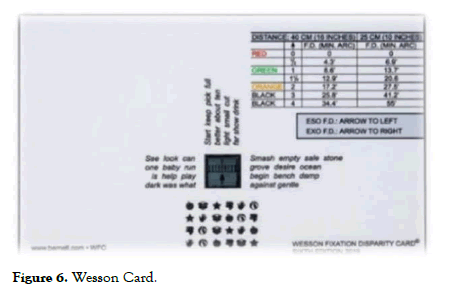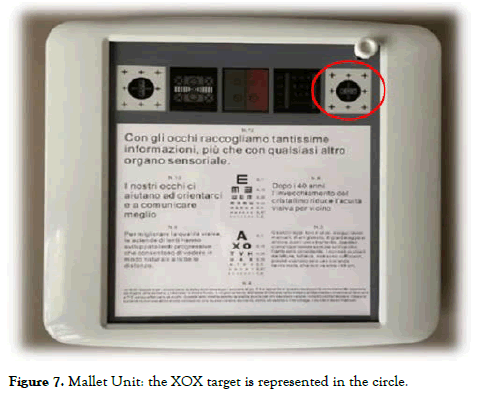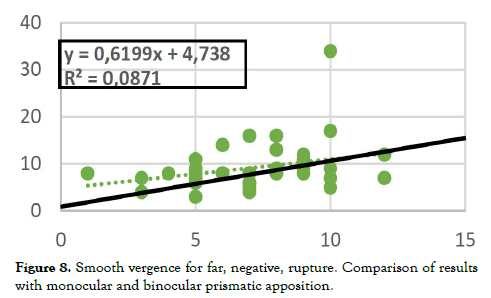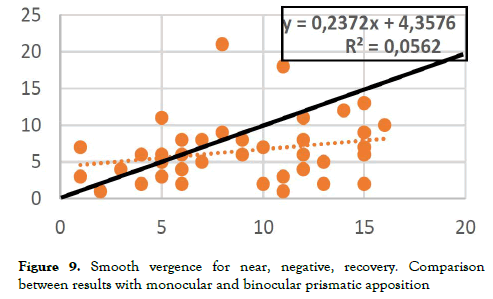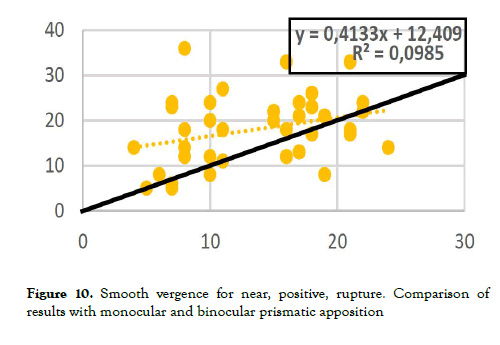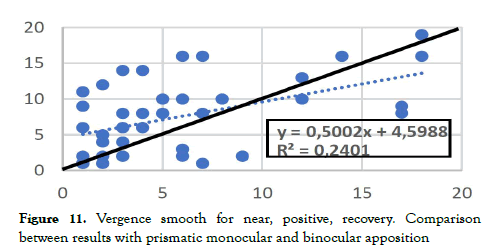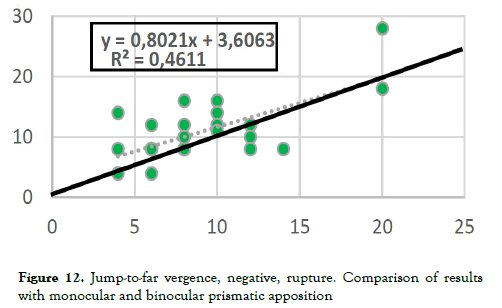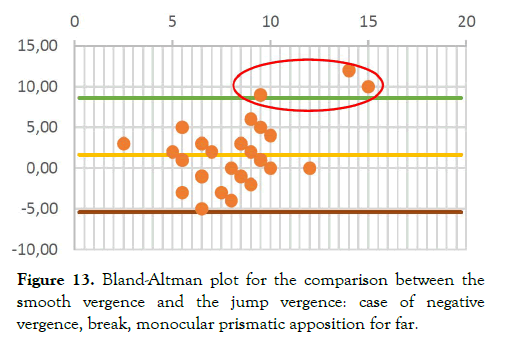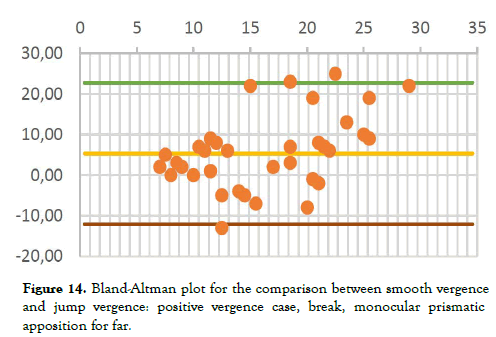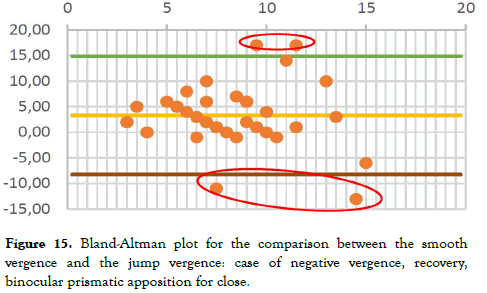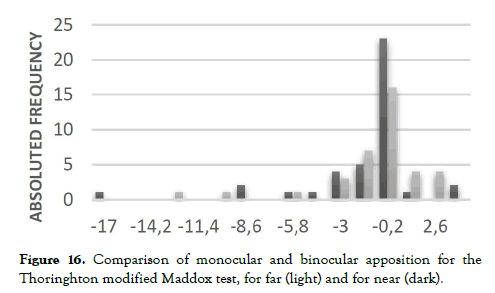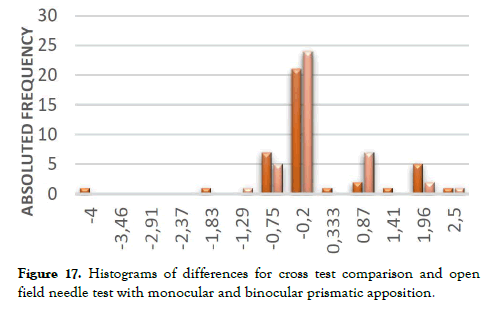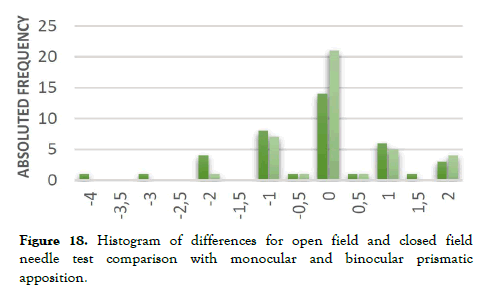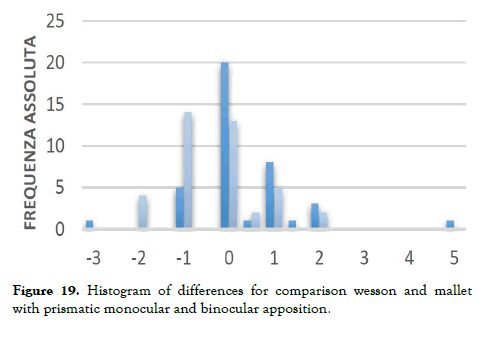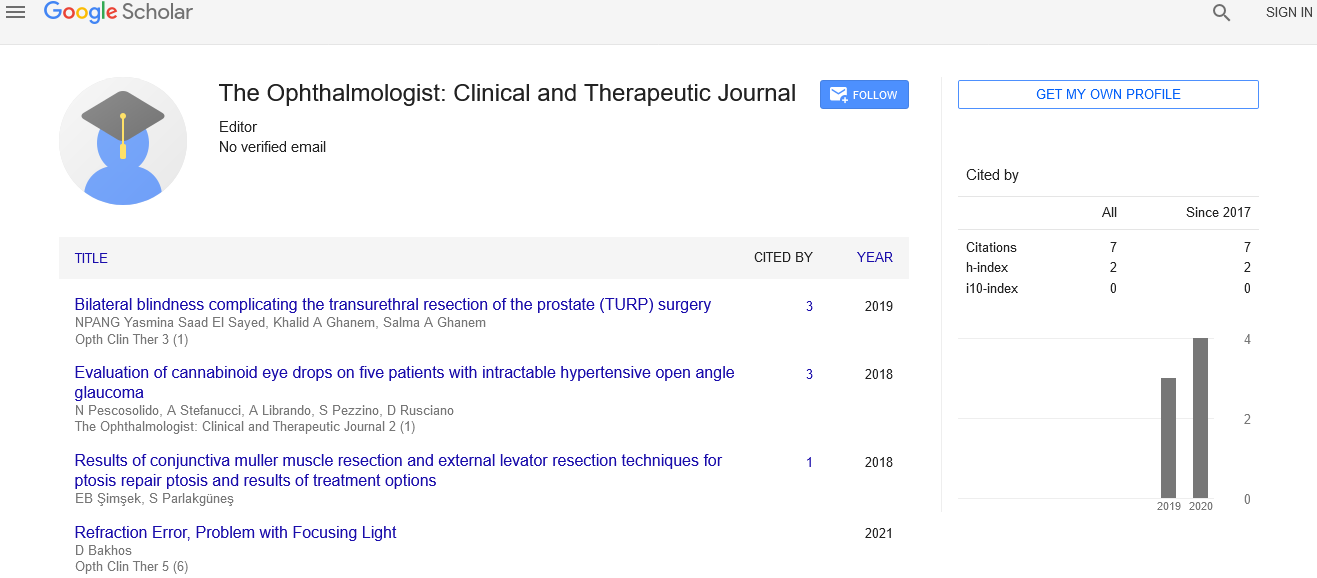Subjective measurement of fusional vergences, dissociated heterophorias and associated heterophorias: comparison between monocular and binocular prismatic apposition
Received: 18-Jan-2022, Manuscript No. PULOCTJ-22-4739; Editor assigned: 21-Jan-2022, Pre QC No. PULOCTJ-22-4739(PQ); Reviewed: 07-Feb-2022 QC No. PULOCTJ-22-4739; Revised: 21-Mar-2022, Manuscript No. PULOCTJ-22-4739(R); Published: 29-Mar-2022
Citation: Gelain M. Subjective measurement of fusional vergences, dissociated heterophorias and associated heterophorias: comparison between monocular and binocular prismatic apposition.. Opth Clin Ther J 2022;6(2):1-19.
This open-access article is distributed under the terms of the Creative Commons Attribution Non-Commercial License (CC BY-NC) (http://creativecommons.org/licenses/by-nc/4.0/), which permits reuse, distribution and reproduction of the article, provided that the original work is properly cited and the reuse is restricted to noncommercial purposes. For commercial reuse, contact reprints@pulsus.com
Abstract
Purpose: The aim of the study was the measurement of fusional, dissociated and heterophory vergences associated with the phoropter both in the open field, by comparing the data obtained in monocular and binocular prismatic apposition. Most of the studies in the literature, in fact, have compared the various measurement methods with each other but have not made a direct comparison between the results in monocular and binocular conditions.
Methods: 40 subjects (age 22,5 ± 3,1) were examined in which the lenses of the subjective refraction performed at the phoropter were worn during the tests, then balanced with Humpriss in the open field. For each subject, the following were measured from afar (6 metri) and near (40 centimetri): the smooth fusional vergences (phoropter) and jumps (open field), the dissociated heterophorias by means of the Von Graefe test (phoropter) and the of Maddox modified Thoringhton (open field) and finally, the heterophoria associated for distance, through the cross and needle test both to the phoropter and in open field and the associated heterophorias for near through the Wesson card (phoropter) and the Mallet Unit (open field).
Results: Tests on the data revealed significant differences between the test results obtained with monocular and binocular prismatic apposition, and it was determined that there is a statistically significant difference between the two measurement methods, especially with regard to the data in the open field. The difference in merger virginity was greater above all on breakdowns and recoveries for the most part negative and for the least part positive. In the heterophorias the difference was significant above all for the data in the open field, probably due to the greater presence of fusional recalls.
Conclusions: The results of the study showed a new perspective on binocular vision investigation methods. In this regard, in order to have a more specific and broader understanding of the commonly used procedures, it would be useful to deepen the study with a larger sample both in terms of number and variety.
Keywords
Fusional vergences; Dissociated heterophorias; Associated heterophorias; Monocular prismatic apposition; Binocular prismatic apposition; Open field; Closed field
Introduction
In the procedures of analysis of the visual system, tests for the evaluation of the binocular area have usually been included, because, as indicated by the review study of in the presence of binocular vision abnormalities, Stakeholders reported a wide variety of disorders. The tests that have described the binocular aspects and therefore the tests of the dissociated heterophorias, associated and fusional vergences, are many and have been differentiated both for mode of execution and for the instrumental apparatus. In this regard, since the various measurement methods are often compared in the literature, but there is no in-depth analysis of the individual methods, the study aimed to study the most widespread test methodologies of these aspects, measure the difference between monocular and binocular prismatic apposition with different methods of investigation in open field and closed field (phoropter) [1].
Study of fusional vergences
When the object to be observed approaches the eyes, the image moves away from the fovea creating disparity between the two eyes. Fusional vergences or amplitudes are the result of a motor response to a stimulus caused by the movement of the object’s images and a subsequent corrective movement of both eyes in order to avoid diplopia and maintain binocular vision. The vergence movements, which include convergence and divergence, are then defined as joint repositioning of the eyes on the horizontal plane. When the movement of the eyes occurs in convergence there is a rotation towards the nose, when the movement occurs in divergence the rotation is towards the temple. These repositions strongly depend on the initial position of the visual axes (the movement is faster for initially close targets). A careful examination of the fusional differences is essential since the possible presence of anomalies in this system can generate a variety of disturbances that interfere with visual comfort, resulting in the inability to maintain binocular vision with a comfortable alignment [2].
Study of heterophorias
Binocular measurements include those that involve latent deviations on the visual axes. Dissociated heterophoria represents, in fact, the relative ocular rotation of the eyes during the binocular fixation of an object in the absence of a fusional stimulus. The rotation can be inward (eso) or outward (exo), upward (hyper) or downward (ipo) or in the absence of movement (orto). Clinically it can be measured with many techniques that use different stimuli, dissociation methods, and subject instructions. In practice the most commonly used are the von Graefe method and the Maddox method. Although some authors have argued that the measurement of dissociated heterophorias is not useful in the evaluation of binocularity decompensating disorders, these tests have been routinely used as part of diagnostic criteria for many abnormal conditions of binocular vision [3].
Another aspect of binocular vision is Disparity in Fixation (DF), which is not optimal in individuals with respect to the control of binocular eye movement and subsequent neural processing. It is well documented that most subjects with dissociated heterophoria to which prisms are prescribed end up responding with an increase in deviation and this phenomenon is commonly referred to as "motor adaptation" or "prism adaptation. Instead, since fixation disparity can be a symptom of binocular stress or a signal of intentional error aimed at driving the eye movements of vergence, the amount of prism that reduces fixation disparity to zero, or the associated form, should relieve the ailments and indicate the most appropriate prism for prescription. There are two types of DF that differ in measurement methods, physiological mechanism and application area. The objective DF refers to the oculomotor position of the two eyes that is to the angle of convergence between the visual axes and can be measured with eyetrackers. In this case the images of an object in space, produced by the two eyes, are not projected on corresponding retinal points but the object is perceived as single. It will then be the neural mechanism of sensory fusion to attribute to the two retinal images the same visual direction. Instead, to test the subjective DF it is necessary to use, in addition to a binocular fusional stimulus, two monocular stimuli; the perceived physical separation between the two stimuli seen respectively monocularly will indicate the value of the subjective disparity. The disparity of fixation in its differentiation between subjective and objective thus represents the different physiological mechanisms of motor and sensory fusion [4,5].
Monocular and binocular prismatic apposition
When prismatic lenses are placed in front of one or both eyes, they move the image to a different point along the retina, generating a change in the toned position of the eyes.
In this regard, it was the study by Santos, et al. that tried to determine whether the horizontal prisms symmetrical to prisms affixed in an asymmetric manner provoked different rates of adaptation, indicating that, for subjects with normal binocular vision, adaptation to the asymmetric prism was significantly faster than adaptation to the symmetric prism. This is because the asymmetric condition generates a combination of saccharide and vergence movements that interact in a non- linear way (additive hypothesis) [6].
When a change in convergence is not accompanied by the accommodative as is usually the case, the Foria (when measured immediately after the prismatic apposition) changes by an amount equal to the power of the prism and in a direction opposite to its base (a prism of 4 dpt with an external base induces a 4 dpt internal base). This happens for a limited time and after a few minutes the Force returns to its previous amount. This process of return to the status quo is called prismatic or vergence adaptation and can be accomplished even when previously no binocular vision has occurred. For this reason, the result of almost all clinical trials for heterophoria can be deviated from the prism adaptation process, particularly when the variable prism was not set to zero before starting the test [7].
Measurement in open and closed field
In the evaluation of the binocular aspects, the different studies in the literature do not clarify unambiguously whether testing the subject through the phoropter or in free space alters the entity of the oculomotor deviations. The research of Frantz and Scharre, for example, has stated that the differences between open field and phoropter measurements were produced by the different convergence response induced by the phoropter which was dependent on proximal convergence, the position of the eyes and head and the restriction of the peripheral visual field. London also stated that subjective measurements of heterophoria, carried out through a forgo, showed an increase or decrease in exophoria due to the effects of proximal vergence but did not submit data in support of this proposal. In the study by Casillas and Rosenfield, Burian’s research was cited where it was stated that the inclusion of a higher degree of peripheral retina was translated into a significant increase in the amplitude of fusion in normal subjects. Therefore, it was possible that the presence of peripheral fusional stimuli influenced the position of the eyes during open field heterophoria testing by producing a more stable vergence response [8].
Study objectives
The aim of this study has been the measurement of fusional vergences, dissociated heterophorias and heterophorias associated both with phoropter and in the open field, comparing the data obtained with monocular and binocular prismatic affixation. This is because many previous studies in the literature compared the various measurement methods but did not make a direct comparison between the results in monocular and binocular conditions. Since, in the procedures of analysis of the visual system, tests for the evaluation of the binocular area have usually been inserted, as in the presence of binocular vision abnormalities, the interested subjects report a wide variety of disorders, this was relevant [9,10].
Materials and Methods
Selection of participants and inclusion criteria
The sample included 40 randomly recruited subjects aged 19-31 (with an average of 22.5 3.1). All subjects presented binocular vision with no pathological abnormalities. The test order for each test subject was randomized (the tests were presented with a different sequence for each test) to reduce any non-random displacement of the resulting values [11].
Refraction and balancing
The refraction was performed subjectively to the phoropter with Ottotipo Snellen on LCD screen placed 6 meters from the examined and then balanced in open field, with the test goggles, through the method of the suspension foveale (Humpriss). All the tests were carried out with the lenses of the subjective refraction for far and near, inserted on the goggles or on the phoropter depending on the tests [12].
Methods of measuring melting
The fusional differences (V) were detected from afar (L) and up close (V). Jumps (VS) in the open field were measured with Berens slats and smooth (VL) rods in the closed field with Risley’s rotating prisms in the phoropter. Prisms monocularly (M) and binocularly (B) were affixed to each of the above conditions. Between the values are reported data of clouding (A) breakage (RO) and Recovery (RE).
Jump vergences
Clinically, the measurement of jump vergences has some advantages, among which the peripheral perception that represents a more natural test environment when compared to phoropter. The examiner moved a single Berens splint in front of the right eye during the measurement of the jumps during the monocular application phase Figure 1 maintaining a constant speed and a correct alignment position so as not to induce changes in the prismatic effect. In the phase of binocular apposition were used two Berens slats connected to a support that allowed it to slide while maintaining alignment with the visual axes of the subject.
Smoot vergences
The measurement of the smooth vergences was carried out at the phoropter by means of Risley’s rotating prisms (Figure 2). In the phase of monocular apposition, only one rotating prism was used in front of the right eye, while in the second phase both were used. The forklift has been set with the subject’s visual axis distance for both near and far. For both measurements at a distance, the target has been used with a vertical octatypal line corresponding to 20/25 placed at 6 meters while for the proximal measurement an octatypic line of 20/25 placed at 40 centimeters. Costa and Rowe review studio stated that some studies do not agree on the order in which it is more appropriate to measure the fusional vergences despite the fact that the most commonly accepted technique is to first measure the negative fusional vergence followed by the positive fusional vergence to avoid influence the value of convergence recovery due to excessive stimulation of convergence. For this reason, the negative vergences were always measured first and then the positive ones. Each subject was then asked to inform the examiner when the target.
Methods ond measuring heterophorias
Dissociated heterophorias Von Graefe: The Von Graefe method was used to assess the direction and extent of the horizontal dissociated heterophoria at the phoropter, from far (L) and from close (V) with monocular prismatic (M) and binocular (B) affixation. The aim used was a line of vertical letters placed at 6 m for measurements from afar and at a distance of 40 cm for the neighbor. A high-base 6 Δ prism was fixed in front of the right eye of the subject and a 12 Δ internal- based prism (monocular apposition phase) was placed in front of a single eye to create a translated diplopic image and two prisms with an internal base of 6 Δ in front of both eyes (binocular application phase). Starting from this condition, the addition of Risley prisms generated a molten image and the resulting prism was the size of the Force. Among the indications given to the subjects examined, it was requested to keep the letters of the observed aim sharp. Generally, to maintain control of accommodation and not to induce Force fluctuation and decrease test reliability, It is necessary that the subject does not fix the image generically but keeps the letters sharp throughout the test time until the two images are perfectly aligned [13].
Maddox modified Thoringhton: The modified Thoringhton Maddox method (Figure 3) was used to assess the direction and extent of a horizontal heterophorias in the open field. In this case, the Maddox headstock was placed in front of the subject’s right eye (a series of very powerful cylindrical elements that blur a point of light and create a focal length). The subject’s eyes were at this point dissociated and assumed the position of heterophoria. The extent of the deviation of the subject was given by the power of the prism necessary to bring the strip back to the central position.
Associated heterophorias: Associated heterophoria differs from dissociated heterophoria in the presence of a fusional block. Clinical measurements of the heterophoria associated with the distance of 6 meters (L) and the close distance of 40 centimeters (V) are performed. Also in this case the measurements were repeated with the insertion of the monocular compensation prism (M) and binocular (B). For the test from afar were used cross tests (cross test) and needle test, which are part of the Haase sequence while close up were used the Mallet Unit for open field measurements and the Wesson card for measurements to the ravine. In all these tests partial dissociation was obtained by means of polarized filters.
Cross test
It was run at a distance of 6 meters, at the ravine and in the open field. The vertical line is seen from the right eye and the horizontal line is seen from the left eye (Figure 4). When the subject showed a displacement of the lines, the value of the necessary prism (BI or BO) was inserted in front of one eye (monocular apposition phase) or in front of both (binocular apposition phase) until complete cancellation of the deviation or associated heterophorias, thus achieving total correction. In case of foveal suppression one of the two broken lines was absent or the central space increased.
Needl test
It was run at a distance of 6 meters, at the ravine and in the open field. The examiner verified that the subject saw the needle with the OD, the indicators with the OS and with both eyes the central dot which, together with the instrument frame, represented fusional blocks (Figure 5). The prisms (BI or BO) required for the deviation compensation have been inserted on the test goggles in the same way as the measurement at the phoropter.
In the test, with the Wesson card (Figure 6) placed on the rod at a distance of 40 cm and with the use of polarized filters, Risley prisms were set to zero in front of each eye and the subject was instructed to report to the examiner the relative placement of the lower arrow. The value of the compensation prism needed to align the arrow has been annotated. Measurements were made within 15 seconds to minimize the adjustment to vergence.
Wesson Card
Mallet Unit
It was used for testing at a close range of 40 centimeters and in the open field. The target was the word XOX seen with both eyes while the two nonic lines were seen monocularly (Figure 7). The subject was invited to look at the O and report when the two lines were aligned with it. At a time when, even after a wink, the lines remained aligned, the amount of prism inserted was considered prescriptible.
Figure 7: Mallet Unit: the XOX target is represented in the circle.
Results and Discussion
The measurements carried out made it possible to make a comparison of the data of the fusional vergences, the dissociated heterophorias and the associated ones, obtained with monocular prismatic apposition and with binocular apposition both in the open field and at the phoropter. Given the vast amount of data obtained, they have been summarized in acronyms. To study the comparison between samples, the Wilconxon parametric test was applied, considering a level of significance equal to 0.05: in the following tables (Tables 1-5) the tests that detected a significant difference were highlighted. Given the dubious overestimation of some data of the vergences with respect to others, the significance (p-value 2) has been checked again, eliminating some values (represented inside the circles in the figures reported later). If the deletion of such data has changed the outcome of the test, there is an indication as to why the tests are not compatible: the latter have confirmed in all cases the difference in significance.
| COMPARISON MONO- BINO | p-value 1 | p-value 2 |
|---|---|---|
| Vs FNBM – Vs FNBBI | 0,023 | 0,039 |
| Vs NNEREM – Vs NNEREBI | 0,003 | |
| Vs NPBM – Vs NPBBI | 0,002 | |
| Vs NPREM – Vs NPREBI | 0,041 | 0 |
| Vj FNEBM – Vj FNEBBI | 0,001 | |
| Vj FNREM – Vj FNREBI | 0,012 | |
| Vj NNEREM – Vj NNEREBI | 0,004 |
Table 1. P-value values obtained from the Wilconxon non- parametric test for comparison between monocular and binocular smooth vergences (Vs), and for comparison between monocular and binocular jump (Vj) vergences
| COMPARISON MONOCULAR VS -VJ | p-value 1 | p-value 2 |
|---|---|---|
| VS FNEBM – VJ FNEROM | 0,010 | |
| VS FNEREM – VJ FNEREM | 0,001 | |
| VS FPREM – VJ FPREM | 4*10^-4 | 0,002 |
| VS NPBM – VJ NPBM | 0,001 | 0,018 |
| VS NPBM – VJ NPBM | 1*10^-5 |
Table 2. Values of p-value obtained by the Wilconxon non- parametric test for comparison between monocular smooth vergences (VSs) and monocular jump vergences (VJ).
| COMPARISON BINOCULAR VS -VJ | p-value 1 | p-value 2 |
|---|---|---|
| VS FNEBBI – VS FNEBBI | 0,043 | |
| VS FNEBBI – VS FNBBI | 0,003 | |
| VS FPREI – VS FPREBI | 0,002 | 4*10^-4 |
| VJ NNEREBI – VJ NPREBI | 2*10^-4 | 1*10^-5 |
| VJ NPOBBI – VJ NPBBI | 0,016 | |
| VJ NPREBI – VJ NPREBI | 1*10^-5 |
Table 3. Values of p-value obtained by the Wilconxon non- parametric test for comparison between binocular smooth vergences (Vs) and binocular jump vergences (VJ).
| COMPARIS DISSOCIATED HETEROPHORIAS | p-value |
|---|---|
| MADDOX MODIFIED | 0,0455 |
| THORINGHTONMF VS MADDOX | |
| MODIFIED THORINGHTONBIF | |
| MADDOX MODIFIED | |
| THORINGHTONMN VS MADDOX MODIFIED THORINGHTONBIN | 0,0062 |
Table 4. P-value values obtained using the Wilconxon non- parametric test for comparison between monocular and binocular dissociated heteroforias, for near (N) and far (F).
| COMPARIS ASSOCIATED HETEROPHORIAS | p-value |
|---|---|
| CROSS TESTMF in open field VS | 0,044 |
| CROSS TESTBIF in open field | |
| NEEDL TESTMF in open field VS | 0,022 |
| NEEDL TESTBIF in open field | |
| MALLETMn in open field VS | 0,001 |
| MALLETBIN in open field. | |
| CROSS TESTMF in closed field VS | 0,021 |
| CROSS TESTMF in open field | |
| NEEDL TESTMF in closed field VS | 0,036 |
| NEEDL TESTMF in open field | |
| WESSONMn in closed field VS | 0,002 |
| MALLETMV in open field. | |
| CROSS TESTBIF in closed field VS | 0,003 |
| CROSS TESTBIF in open field. | |
| NEEDL TESTBL in closed field VS | 0,019 |
| NEEDL TESTBL in open field. |
Table 5. P-value values obtained using the Wilconxon non- parametric test for comparison of monocular and binocular associated heteroforias for near (N) and far (F).
For comparisons where the conclusion was that there was a significant difference, three different analyses were carried out in order to understand the type of discrepancy found in the data. With an XY dispersion graph (Figures 8-12) the two different types of measurement have been linked, assuming as a model the equality of the two measures and then the bisector of the quadrant. The value R², that is the % of variability of the y explained starting from the variability of the x through the linear fit, has been very small for which a great part of the variability is of random type. The results of the vergence study showed that there was a particular relevance, with overestimation, of binocular data compared to monoculars. The significant differences were found mainly for breakage and recovery data for most of the negative vergences and only slightly less for positive vergences [14].
The Bland-Altman plot for the study of vergences reported on ascisses the semi-sum of each single data (x+y)/2 while on ordinates their difference (yx). The points that fell within the 95% confidence interval indicated that the two methods produced consistent results, while the points outside these limits represented the cases of actual discrepancy.
In the analysis it was expected that 5% of the data could fall outside: with a sample of 40 subjects the values are at most two (40*0.05). In the study for comparison with monocular prismatic apposition only the difference between VS FNEBM-VJ FNEBM (Figure 13) and VS NPBM - VJ FPBM
Figure 14 presented three points outside the considered range. The conclusion of the non-compatibility test between the two samples remained unchanged excluding these values.
This last condition occurred for the comparison VS NNEBBI - VJ NNEBBI (Figure 15) in the case of binocular prismatic apposition and even in this case their elimination did not affect the compatibility of the methods. In all cases of significant difference the total average of the differences was never anything and it was possible to note an overestimation of the VJ with respect to the VS.
In the case of dissociated and associated heterophorias, comparative histograms were constructed (Figures 16-19) and showed different asymmetries (positive and negative). The distribution with tail on the left side showed a purely exophoric sample, while the distribution with tail on the right side the presence of a purely exophoric sample. The full version of the thesis shows the individual values of the asymmetries detected by the analysis with Excel.
The condition of exophoria may be due to the fact that the subject used less convergence called by accommodation, in contrast to the exophoric data, especially with regard to remote testing, where greater convergence has been induced in the event that minor fusional calls have occurred.
Conclusions
The objective of the study was to compare different methods of measuring the binocular aspects in order to make a direct comparison between monocular and binocular prismatic apposition. Several tests have been performed to describe such aspects as dissociated, associated heterophoria and fusional differences. They differ in both the mode of execution and the instrumental apparatus.
Conclusion fusional vergences
In the case of mergers, the study in the open field has shown particular relevance, in fact, this has among the advantages the presence of a more natural environment when compared to the phoropter. The positive aspect of this measure was that it presented the subject with a more "real" condition during the measurement so that the sensory and motor aspects of the visual organs worked simultaneously. The comparison between the various monocular and binocular prismatic apposition methods has, in fact, led to satisfactory results. By means of the dispersion diagram it was possible to measure an overestimation of the binocular data with respect to the monocular data and a significant difference especially for the breakage and recovery data for most of the negative vergences and only to a lesser extent in the positive convergence. This was probably due to the fact that the negative vergences were, in fact, less extensive than the positive ones and the subject encountered more difficulties in performing the test. In addition, one reason for having significant differences in breakage data may be that the study was performed on a young sample. Costa and Rowe [2019] have specified, in fact, that one of the probable explanations of having very high values of rupture can be found in having performed the study on young adults and students, subjects therefore with a certain practicality in carrying out the test. The research in question was, in fact, conducted on 40 subjects aged between 19 and 31 years, mostly students of the University of Optics and Optometry of Turin, subjects with a certain knowledge and familiarity in the conduct of the tests to which they have been subjected.
Heterophorias dissociative conclusions
Also in the case of dissociated heterophorias the modified Maddox Thoringhton test showed that there are measurements for open field data. In contrast, the von Graefe test that was performed in the closed field showed no significant differences between comparisons. It has been hypothesized, therefore, that the adaptation to the monocular prism with respect to the binocular can vary considerably when the measurements have not been carried out to the phoropter. In this case the component that made the measure variable was presumably the different peripheral perception. Therefore, as reported in the Burian study it was possible that the presence of peripheral fusional stimuli could influence the position of the eyes during open field heterophoria testing by producing a more stable vergence response. In addition, the histograms of the differences showed mostly a negative asymmetry, detecting the presence of a sample that was shown to be predominantly exophoric, probably due to the greater contribution of accommodation and convergence required in this condition. Although some authors have argued that the measurement of dissociated heterophoria is not useful in the evaluation of disorders that decompensate binocular vision. These tests have been routinely used as part of diagnostic criteria for many abnormal conditions of binocular vision.
Associated heterophorias conclusions
Significant differences between monocular prismatic and binocular apposition for open field data have also been highlighted in the study of associated heterophorias. Overall, the comparative histograms showed positive distributions and a greater presence of exophoric subjects (negative) in monocular condition and a greater presence of exophoric subjects (positive tail) in binocular condition. It has been hypothesized that in the binocular data the accommodation was balanced by refraction according to Humpriss and therefore the data tended to move towards exophoria and not to have convergence recalled by accommodation. A different condition for the exophoric data, especially with regard to the tests from afar where greater convergence has been induced in case of minor fusional calls. The distribution of differences in the results of the Mallet test with monocular and binocular prismatic affixation also presented an exophoria condition. It was a test performed at a close distance of 40 cm in fact, according to what has already been said, this may be due to the fact that, close up, the subject used less convergence recalled by the accommodation. In the comparison between the needle test and the cross test, there were more negative monocular and binocular differences in the cross test and more positive monocular and binocular differences in the needle test. Evidently the sample in the cross test was mostly exophoric given the absence of a central fusional recall in the aforementioned, present instead in the needle test where the sample was mostly exophoric. In fact, the only test that showed no significant difference between open field and closed field measurements was the cross, which lacked the central fusional recall, which is probably why it was less susceptible to peripheral differences. It was not excluded that these exophoria values are normally more acceptable than exophoria values; this was a greater indication that the sample examined did not show any particular binocular abnormalities. Since in clinical practice the measurement of associated heterophorias is very often performed in the open field, what was obtained in this study was relevant [15].
General conclusions
Overall, it was found that for the measurement of vergences, dissociated heterophorias and associated heterophorias, the methods involving monocular and binocular prismatic apposition could yield significantly different values. This was especially relevant for open field and binocular data. Currently it may be useful to perform both measurements (with monocular and binocular prismatic apposition, in the open field and in the closed field) on the subjects to study this difference but in a future perspective it would be useful to design a study to understand what are the measures that best describe the real condition of the subject. In any case, the binocular prismatic apposition in the open field was the most optimal condition, considering that it reflects the most natural situation to which the subject was normally accustomed. For a future perspective, given therefore the significant differences, it would be necessary to probe these lines of research increasing the number of the sample and its composition as age and physical condition, in order to achieve a more specific and comprehensive understanding of the commonly used procedures for evaluating binocular vision.
References
- Antona B, Barrio A, Barra F, et al. Repeatability and agreement in the measurement of horizontal fusional vergences. Ophthalmic Physiol Opt. 2008;28(5):475-91.
[Crossreff] [Googlescholar] [Indexed]
- Barnard NAS. A quantitative analysis of eye movement characteristics during the cover test. Doctoral dissertation, City University 1999.
[Googlescholar] [Indexed]
- Brautaset RL, Jennings JA. Associated phoria and the measuring and correcting methodology after H.-J. Haase (MKH). Strabismus. 2001;9(3):165-76.
[Crossreff] [Googlescholar] [Indexed]
- Bruce J, Evans W Pickwell’s Binocular Vision Anomalies. Elsevier. 2002
- Casillas EC, Rosenfield M. Comparison of subjective heterophoria testing with a phoropter and trial frame. Optom Vis Sci. 2006; 83(4):237-41.
[Crossreff] [Googlescholar] [Indexed]
- Dowley DA. Fixation disparity. Optometry and vision science: official publication. Optom Vis Sci. 1989;66(2):98-105.
- Facchin A, Maffioletti S. La visione nell’apprendimento del bambino. Franco Angeli 2016
- Frantz KA, Scharre JE. Comparison of disparometer fixation disparity curves as measured with and without the phoropter. Optom Vis Sci:. 1990;67(2):117-22.
[Crossreff] [Googlescholar] [Indexed]
- García-Muñoz Á, Carbonell-Bonete S, Cacho-Martínez P. Symptomatology associated with accommodative and binocular vision anomalies. J Optom. 2014;7(4):178-92.
[Crossreff] [Googlescholar] [Indexed]
- Jaschinski W. Individual objective and subjective fixation disparity in near vision. PloS one. 2017 Jan 30;12(1):0170190.
[Crossreff] [Googlescholar] [Indexed]
- Lança CC, Rowe FJ. Measurement of fusional vergence: a systematic review. Strabismus. 2019 Apr 3;27(2):88-113.
[Crossreff] [Googlescholar] [Indexed]
- Larson WL. Prism adaptation without binocular vision is unlikely: a retraction of a claim to the contrary. Optom Vis Sci. 1992; 69(4):336.
[Crossreff] [Googlescholar] [Indexed]
- Santos EM, Yaramothu C, Alvarez TL. Comparison of symmetrical prism adaptation to asymmetrical prism adaptation in those with normal binocular vision. Vision research. 2018;149:59-65.
[Crossreff] [Googlescholar] [Indexed]
- Scheiman M, Wick B. Clinical Management of Binocular Vision. Lippincott Williams andWilkins. 2002.
- Wesson MD, Amos JF. Norms for hand-held rotary prism vergences. Am J Optom. 1985;62(2):88-94.




